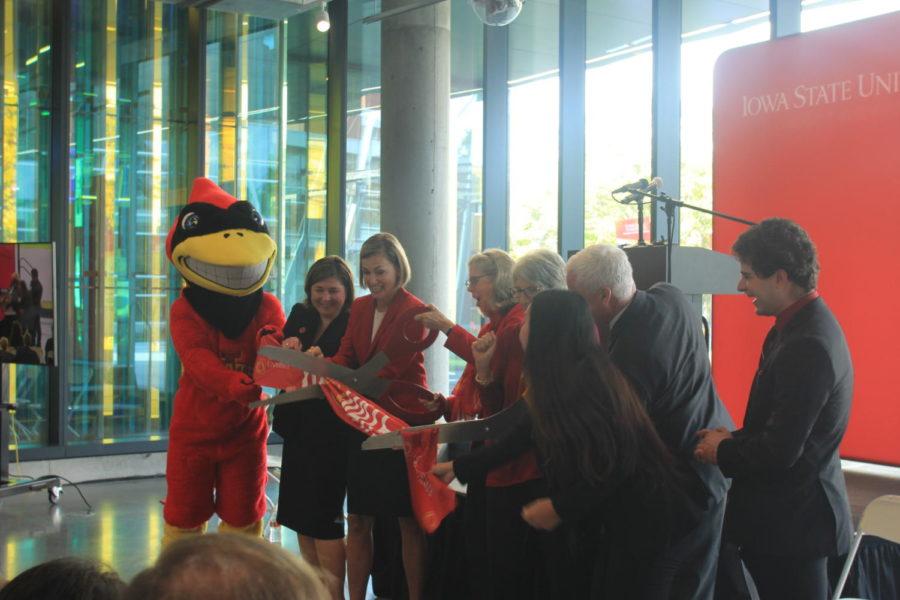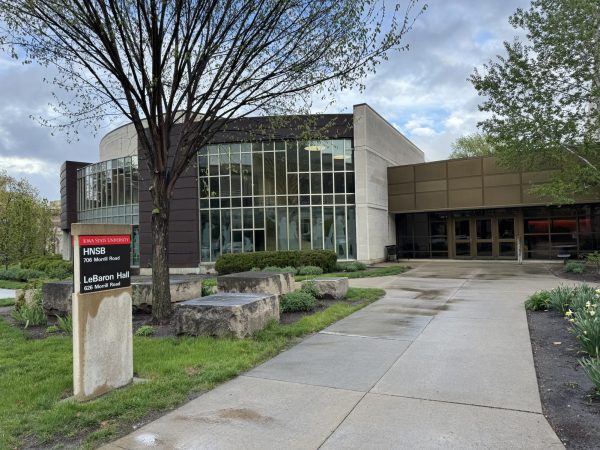Iowa State’s Student Innovation Center held its dedication and ribbon cutting Thursday afternoon
September 30, 2021
Iowa State hosted the Student Innovation Center’s official dedication and ribbon-cutting (SICTR) Thursday, years after an anonymous donation spurred the idea into existence. The SICTR first opened in August of 2020 but recently held the dedication and ribbon-cutting in honor of the countless workspaces and state-of-the-art pieces of equipment that now inhabit the facility.
The event featured many speakers: President of Iowa State University, Wendy Wintersteen, Gov. Kim Reynolds, Board of Regents representative, Sherry Bates, President of the ISU Foundation, Larissa Jones and Director of the Student Innovation Center, James Oliver, as well as two members of the Innovative Fellows Program, Sarah Ng and Ayman Karmi. All speakers expressed their gratitude for the anonymous couple who helped to fund the project.
Wintersteen remarked on SICTR, calling it a “four-story, 140,000 square foot dream factory.” She expressed how the center’s creation shows the university’s commitment to students and helping them develop into innovators and entrepreneurs.
Reynolds spoke on the importance of the SICTR in helping to make Iowans future-ready and to fuel the workforce with smart, experienced people.
The Innovative Fellows featured during the ribbon-cutting both gave their appreciation to the facilities and people at the SICTR who have helped them in their projects and activities.
After the speakers gave their remarks, the ribbon was presented to the speakers wielding massive ribbon-cutting scissors. Despite the size of the ribbon scissors, they were unable to cut through the ribbon, and Gov. Reynolds stepped in with a normal pair to finish the commemoration of the SICTR.
The $84 million project was funded by a donation of about $30 million from an anonymous couple and donations from corporate sponsors and alumni. The State of Iowa also committed $40 million to go towards the creation of the facility.
The Student Innovation Center puts students at the center of their own learning rather than filtering them through the various colleges and programs at Iowa State. The SICTR provides students with a place to pursue their own projects and ideas in a setting closer to the real world.
In an interview after the ribbon-cutting, Oliver spoke on the SICTR and the novelty of its concept.
“It doesn’t happen very often at universities, usually resources are allocated to departments or colleges or specific degree programs and so having this much flexibility is very unique,” said Oliver. “It’s about bringing people together that wouldn’t normally run into each other.”
Interactions between multiple experts drive most innovations and successful businesses. This can be foreign to the format of much of university, in which students mostly interact with people in the same college or field.
“It’s about the exposure to life in the real world, when you start university you declare a major and they tell you to take a certain number of courses in a certain order, then you get some gen eds and some electives,” said Oliver. “You’re basically declared an engineer or a chemist or a designer at the end of four years, and then you go to the real world and it’s nothing like college at all, there are all kinds of other experts that have to come together. Getting exposed to other people, whether it’s through projects, learning crafts like glass blowing, or using these machines, exposes you to things that are unusual and uncomfortable and it gets you ready to accept other experts as you get out into the real world.”
One student organization that was given a quality facility in the SICTR is the glass blowing club. The current treasurer of the glass blowing club, Jacob Wheaton, explained the club’s inclusion in the center.
“So we had some facilities that were basically a repurposed old lab, we were not able to use that space as well as we probably could have, it was designed for something completely different,” said Wheaton. “Now that we’re in the Student Innovation Center we actually have a space that was designed to be a glass studio. We have some state-of-the-art new equipment that we funded partially on our own, partially through the college, and partially through some donations as well.”
Wheaton continued to remark on the effect the SICTR has on individuals at Iowa State and clubs.
“The point of the SICTR is to help people to experience the things that they probably wouldn’t be able to experience if they weren’t at Iowa State,” said Wheaton. “They get to do things that they never would be able to do otherwise. Having this beautiful space front and center in this building is putting us as a club out there and is helping us to become a bigger and more welcoming club to everybody who wants to join.”
Another student organization given a prominent spot in the SICTR is SAE International, with its largest team being Baja and Formula, with over 200 members in the entire organization. One senior at Iowa State majoring in Mechanical Engineering, Carsen Otremba, explained some issues his student organization has encountered since moving into the SICTR.
The organization had a large shop set up in the basement of the SICTR, with some of the vehicles and teams setting out of the shop on display in the hallway.
“One of the largest issues we’ve had is there’s not enough space in there, it is already cramped and that’s with half the teams in there,” said Otremba. “There’s saws, band saws, basically any tool that we had in [the old shop] they’ve had them plugged in and working for over a year, but we’re not allowed to use them.”
In order for students to use some of the equipment at the SICTR, they need to take the applicable safety courses to ensure students use the proper practices. Unfortunately for the student organizations who need to use some of the equipment, many of the required courses to gain approval to use the equipment do not exist yet.
“We are not allowed to use any equipment in this facility, we have had a bandaid fix of going back to [old facilities],” said Otremba.
According to Otremba, the courses were in the works, but the university was having a hard time finding somebody willing to deal with the politics of giving students unlimited access to power tools.
“Having us in here–I’m excited for the next six years, six years from now I think this will be the best opportunity we’ve ever gotten,” said Otremba.

















